April 28, 2022
How to Write Sales Emails That Engage: Definite Guide + Templates
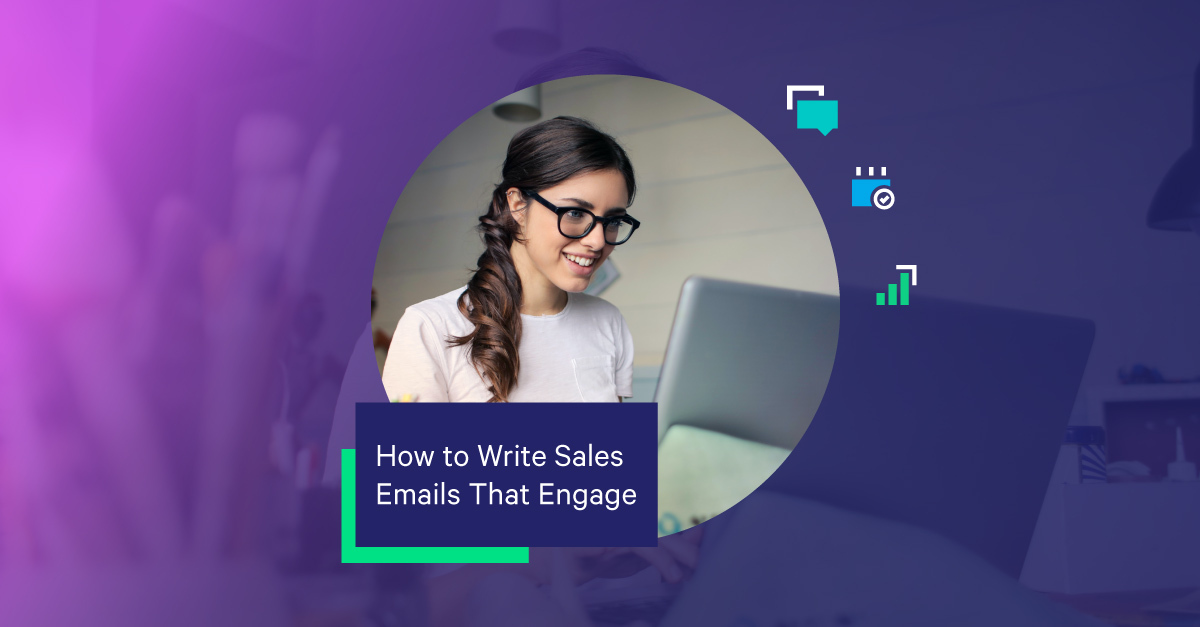
- How to write an effective sales email
- 5 sales email templates every sales rep needs
- Best practices for sales emails that move deals forward
- Frequently asked questions about sales emails
An inbox is not just where your prospects spend 28% of the workday. It’s an opportunistic hub for connections, rapport building, and, if you nail your cold email outreach, a healthy-looking pipeline.
But a good sales email is like a really good blind date. When a true connection has been made, it’s serendipitous and natural. And if it doesn’t feel right? It ends up feeling awkward, or worse, sleazy.

If anything, a good sales email should open doors, not close them.
Luckily, getting on the right side of the track is doable, but only if you’re thoughtful in your approach.
In this handy guide, you’ll learn how to write sales emails that engage your prospects and actually get replies.
How to write an effective sales email
There are six key parts to the effective sales email: the subject line, opening, body copy, call to action, and a signature. And while the whole is greater than the sum of the parts, each section needs to be carefully crafted with a specific goal in mind.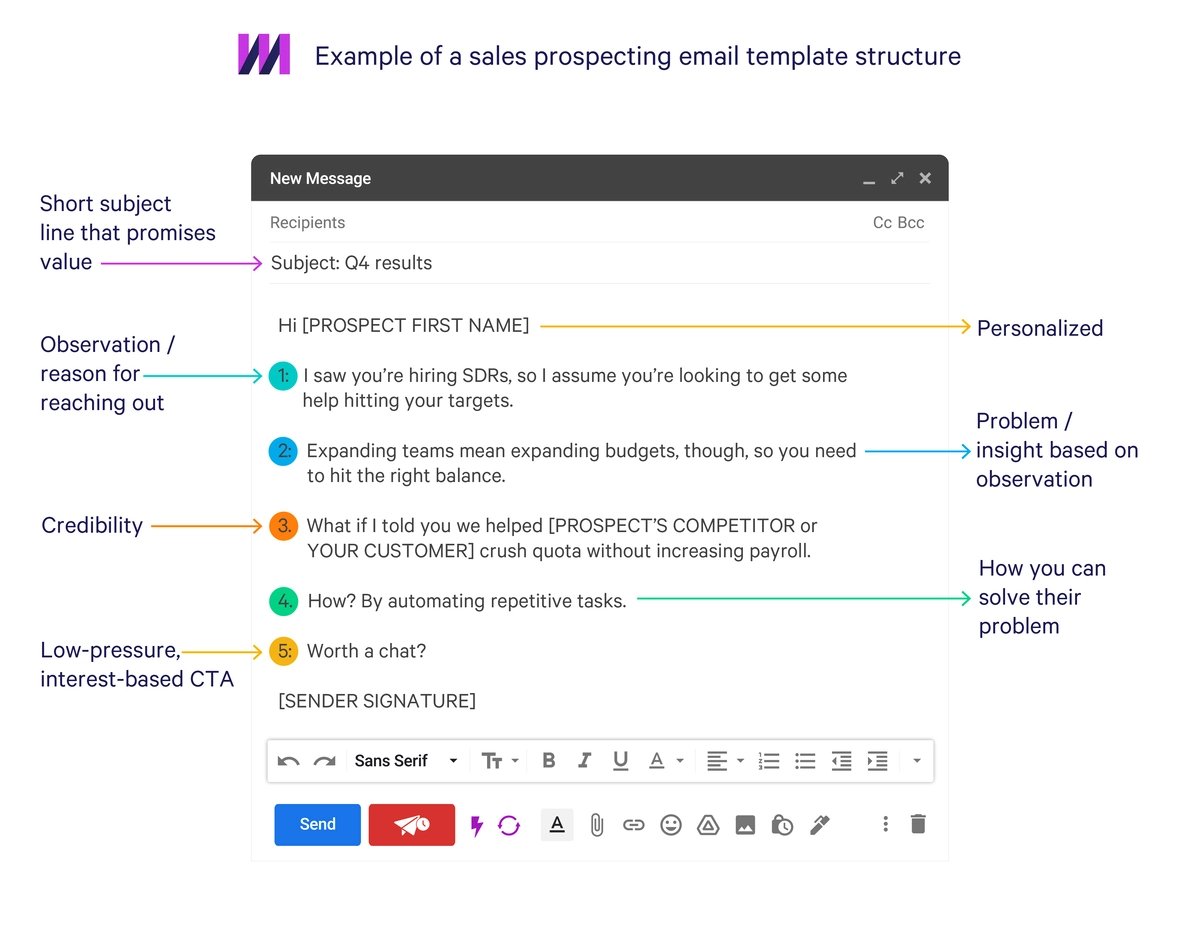
1. Write intriguing subject lines
The notorious email subject line. This is what separates the pro sales reps from the little leagues. Because upwards of 47% of people decide to open an email based on just the subject line, it’s what will help you stand out in that more-crowded-than-a-school-of-sardines inbox.
So if you can’t get this right, you may as well throw the whole email away. Go ahead, scrap the whole thing. If you don’t, your prospect will.

Okay, maybe it’s not that dramatic. But if you fail to promise value that captures their attention, you’ll go straight to “delete” or worse—spam.
First things first, avoid being spammy. We hate spam more than we hate, well, spam.
No offense to the canned pork/ham hybrid of yesteryear, it’s just that spam (of the email sort) leaves a bad taste in the mouth. To ensure you stay out of the spam can—ahem, folder—here are some trigger words to avoid in your subject line:
- Final
- Reminder
- Sale
- Call now
- Specials
- Complimentary
- Help
- Increase sales
- Donation
- Exciting
Next, avoid title case when writing these out. The title case is appropriate for blog posts and headlines, not for email subject lines. Why’s that? Because you always want your emails to feel like you’re sending a letter to a friend. And when was the last time you emailed your old friend like “Cindy, You Won’t Believe How Much This Cost!”
Next, as simple as it sounds, it still happens to even the best of us. When using sales automation, make sure the correct name is in there, there’s no extra spacing or brackets showing. Otherwise…

Finally, here’s what you should do.
Open a loop
Take your subject line up a notch and improve your open rates by adding the curiosity element. Pique their interest without giving it all away. Here are subject line formulas:
- [relevant topic], e.g. "cold email" or "pipeline"
- [Problem your products solve], e.g. "unresponsive prospects"
- [Value proposition in 2-3 words], e.g. "increase rep activity"
- I might be wrong about [common idea], e.g. "I might be wrong about CSMs needing sales engagement too" - ideal for cross-selling.
- Question about [goal], e.g. "Question about predictable pipeline"
- [Name], meet [Name]
Related Post: 75 Sales Prospecting Email Subject Lines to Get More Responses
2. Deliver in your opening lines
The difference between a clickbaity subject line and a really good, tactful one? Closing the loop. That means if you went with the curiosity factor in the subject line, you need to deliver on that in the intro.
If your prospect even gets a whiff of deceit—using curiosity factor only for them to open (and not delivering on the closure) or your subject line doesn’t match the contents of the email, they’ll smell the deceit… immediately.

Next, don’t make the mistake of talking about your product or service right away even if you're cross-selling. Prospects like buying from people they can relate to and trust, so be sure to hit these three things:
- Context: Say why you’re reaching out.
- Trust: Show that you’ve done your homework about the company in case you're reaching out cold. Or share what their other department achieved using your solution when cross-selling.
- Credibility: Show why you’re the person to help.
Then, and only then, you can make a natural segue into your sales pitch.
3. Keep the body concise
The body should be where the actual outreach is implemented.
You may have heard, “your prospects are busy, so keep it short.” But that doesn’t mean you have to quite literally start your email with “I know you’re busy, so I’ll keep this short.” So instead of saying you’ll cut to the chase, just do it!
Your sales email is a delicate balancing act between delivering the message and keeping it snappy enough to where they know more.
To do this, when you talk about yourself/company, make it hyper-relevant to the person you’re emailing. Always ask yourself: why should they care?
Help solve a problem they’re having in just one sentence. You can do this by a simple “Companies like [existing customers similar to your prospect] use [your company] to solve [problem relevant to them] by [how you solve it].”
4. Include a clear call to action
The CTA. If you’re unfamiliar with this term, it’s the ask. After you’ve piqued their interest, delivered value, and proved why you're the right person to help them solve a problem, you then ask them to take the next step with you.
It’s the cherry on top of a deliciously engaging email. And without the cherry, what’s the point? Your prospect will be asking themselves the same thing if they read through an email and aren’t presented with a clear Call to Action—even if they savored the entire thing.
Here are some things to keep in mind:
- The simplest of CTAs can be answered with a simple “yes” or “no.” That’s because your CTA should take the path of least resistance.
- Asking people to do more than one thing muddles the message and causes decision paralysis.
- Your CTA should be directly related to the goal, which we discussed in the body copy section.
- If you're writing the first cold email; don't ask for time, ask for interest. E.g. "Opposed to learning more?"
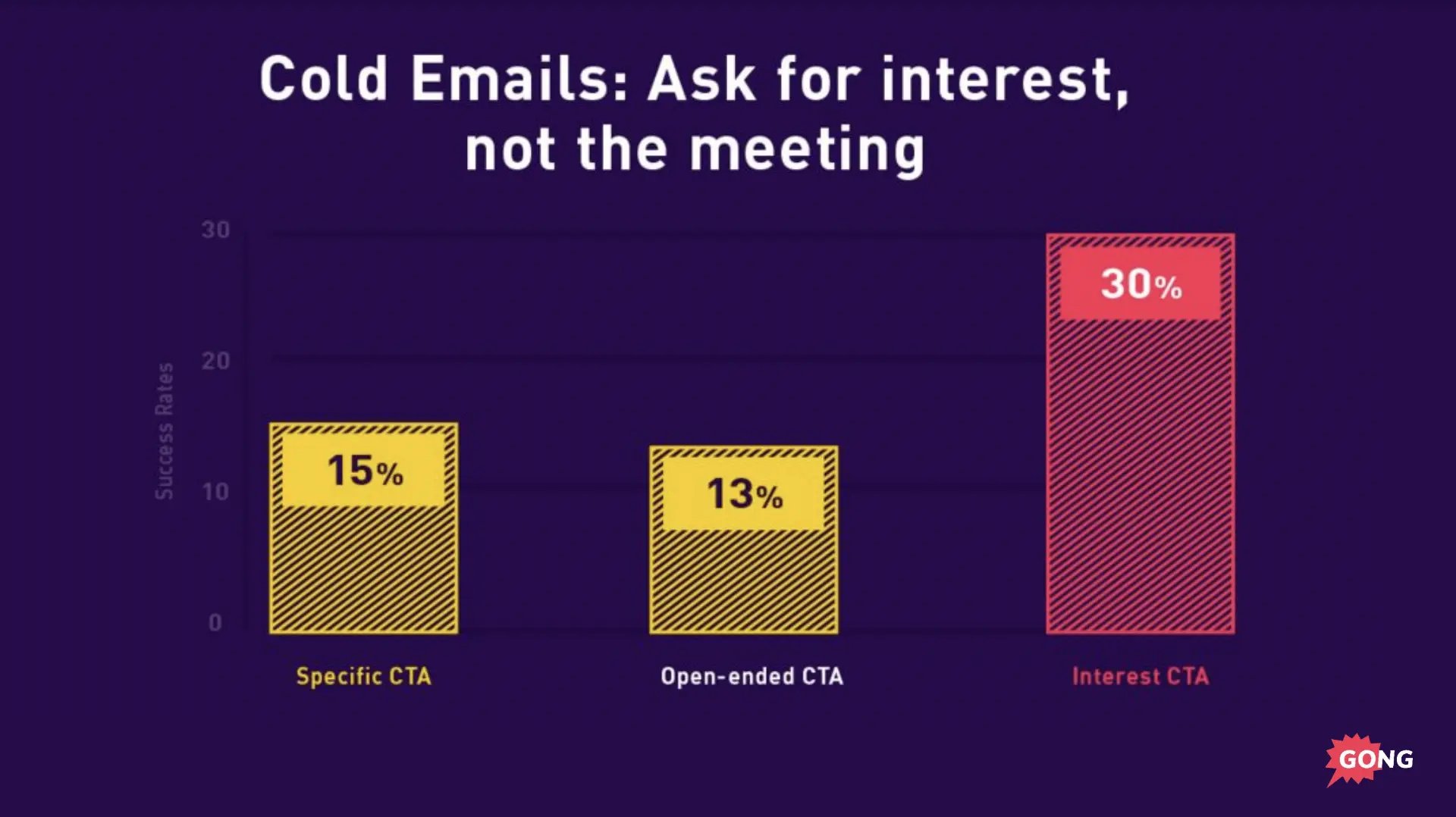
In your follow-up emails, rather than saying “when’s a good time to meet?” which causes your prospect to, well, think about it, simply give them a time and date to accept Yes/No to. For example: “Does Tuesday next week at 11 am work for you?”
Even better, share your availability with Mixmax.
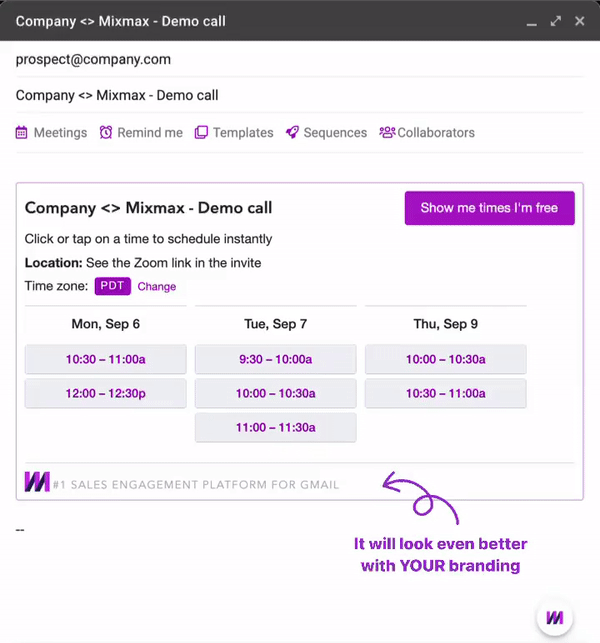
It requires less friction to click a button, you see.
5. Make more use of your signature
Not to be forgotten, your email signature actually takes a good chunk of the space. And yet, it’s easily forgotten about—chalked down to a name, title, and phone number. Well, we’re here to challenge that notion.
First, keep the basics such as name, company, and contact info. Include a photo to cultivate that trust factor. Add any social media links as additional ways to connect with you and see that you are indeed a real human.
Next, think about any newsworthy details you can include such as:
- Your company in the news
- Link to a relevant case study
- Mention of a recent award
Lastly, email signatures don’t have to be boring but they also shouldn’t be a distraction. Keep everything concise and down to the most important details.
Bonus: the P.S.
Listen up, we have a secret weapon for your sales emails arsenal: the P.S. Back in the days of handwritten letters (remember those?), the P.S. was a lifesaver for thoughts that came up after you’ve already signed off.
Professor Siegfried Vögele, author of Handbook of Direct Mail: The Dialogue Method of Direct Communication, reported that 90% of recipients read the P.S. first.
That’s something you can use to your advantage. Here are some ways you can implement the P.S. strategy:
- Use the P.S. to personalize your email further by mentioning why they should care today. E.g. "I thought you'd find this helpful as you just hired 2 new SDRs."
- Mention a testimonial of a company similar to theirs as social proof
- Add a bonus if they act fast (best used when you are trying to close a deal rather than just make the first point of contact)
- Not to contradict ourselves, but if the main CTA is a big ask, you could add a second CTA. E.g. "Still unsure? Hit reply and let’s chat about it!"
5 sales email templates every sales rep needs
How-tos are great, frameworks are even better, but we're going to make this even easier for you. Below are five sales professionals need in a typical sales cycle. Find something for the correct stage of your customer's journey, and customize it to their specific pain points.
1. Prospecting email template
Writing a successful prospecting email today is both art and science. Gone are the days when you could spray and pray.
333.2. That's the number of emails people receive daily. And according to Statista, that number will only increase.
To survive inbox triage and stand out, your cold email should be relevant, personalized, and its value should be perceived within 11 seconds.
Like this one right here👇
New Message
Recipients
- Cc
- Bcc
[PROBLEM YOUR BUSINESS SOLVES]
 Meetings
Meetings Remind me
Remind me Templates
Templates Sequences
Sequences Collaborators
Collaborators
[PROSPECT NAME],
Speaking with [PROSPECT’S ROLE] leaders, they're frustrated that [PROBLEM]. I suspect you're looking into [SOLUTION] to help like they were.
We’ve helped companies such as [COMPETITOR COMPANIES] achieve [SPECIFIC RESULTS] after implementing [YOUR PRODUCT].
Against learning how we could help, [PROSPECT’S COMPANY]?
[SENDER SIGNATURE]

If this one doesn't satisfy your prospecting needs, you can check out 18 more attention-grabbing sales prospecting email templates.
2. Qualification email template
If you have both inbound SDRs who handle inbound demo requests and outbound SDRs focused on booking meetings through outbound efforts, sending a qualification email helps your AEs prepare for the call and ensures prospects are worth their time.
We use Mixmax surveys for ours. Here's what it looks like 👇
New Message
Recipients
- Cc
- Bcc
Subject
 Meetings
Meetings Remind me
Remind me Templates
Templates Sequences
Sequences Collaborators
Collaborators
Thanks for booking time, [FIRST NAME]. We're really looking forward to connecting with you next week!
Just to make sure we are better prepared for our call, please complete the survey below before our call:
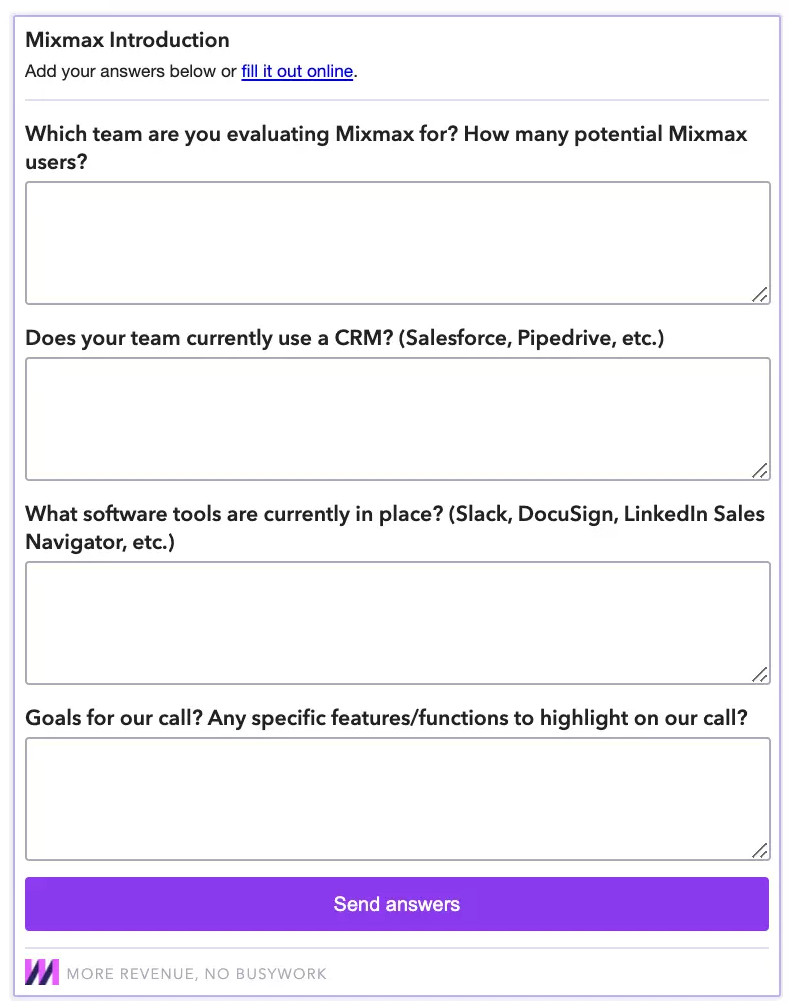
Thanks and looking forward to connecting then!
[SENDER SIGNATURE]

3. Meeting reminder email template
No-shows are a silent quota killer. We’ve all been there. Done the research, fully prepared for an exciting call, and the prospect never shows or cancels last minute.
Jack Wauson, our SDR Manager, shares how to eliminate no-shows with auto-reminders.
"Set your Meeting Template to send an automatic reminder email the day before the meeting. People today are busier than ever! Make it easy for prospects to confirm the meeting and limit no-shows."
New Message
Recipients
- Cc
- Bcc
re: [MEETING TITLE]
 Meetings
Meetings Remind me
Remind me Templates
Templates Sequences
Sequences Collaborators
Collaborators
[SENDER SIGNATURE]

If sent with Mixmax, your meeting reminder email comes with a button to reschedule if they need to. Saves them from making an excuse or waiting until the day of only to no-show, and saves your team from all the back-and-forth in finding a new time.
4. Follow up email template with a mutual action plan
To ensure your salespeople are aligned with your potential customers, create a mutual action plan during the first meeting. It will create a sense of accountability for both the buyer and your reps, and as a result, speed up the sales cycle.
Zen Lenon, an Enterprise AE at our customer Lokalise, explains how to use the MEDDICC framework to create your follow-up template which you can find below.
New Message
Recipients
- Cc
- Bcc
[FIRST NAME] - summary & next steps
 Meetings
Meetings Remind me
Remind me Templates
Templates Sequences
Sequences Collaborators
Collaborators
Hi [FIRST NAME],
Thanks for your time. As promised, below is our summary and next steps.
Summary:
Metrics:
- The team today: 20 reps
- Plan to grow this year: 35 reps
- Meetings per day: 2
- Rep average yearly salary: $
- Annual revenue generated by all reps combined: $
- Emails sent per day: 93
- Meetings scheduled per day: 2
-
Decision Maker
-
Champion
-
Deter
-
Ops
-
Finance
-
Legal
-
How do you purchase software?
-
Understand pricing
-
Scope of work
-
Security Assessment
-
Uptime Status
- SLA/MSA
-
Compelling event
-
Why are you here?
-
Pain point/joy point
-
Current workflow
-
Finance
-
Legal
-
Compelling event
-
Why are you here?
-
Pain point/joy point
-
Who is going to put together the proof of concept?
-
Whom have you vetted?
Next steps:
- Connect with X to get his approval
- [OTHERS]
[SENDER SIGNATURE]

5. Getting ghosted email template
Who doesn't need it? This is not one of those super elaborate templates like the previous one.
But it works.
Why? Because prospects have feelings too. 😅
Show them how being ghosted makes you feel with a GIF.
New Message
Recipients
- Cc
- Bcc
Subject
 Meetings
Meetings Remind me
Remind me Templates
Templates Sequences
Sequences Collaborators
Collaborators
This is me waiting for your reply.

[SENDER SIGNATURE]

Best practices for sales emails that move deals forward
You got the theory and you got the email examples. So, you have everything you need to start writing powerful sales emails that prospects want to respond to. However, especially when prospecting, email may not be enough to move the needle.
Go multichannel: include LinkedIn and phone calls
As Jed says, hit them from all channels. And with the right tool, it can be so much easier.
Mixmax enables you to can start more conversations with prospects and customers with engaging email sequence templates across email, phone, and LinkedIn.
You don't even have to switch tabs. You can access your LinkedIn Sales Navigator and your dialer right within your Gmail.
Personalize your emails (at scale)
While using the prospect’s name in the body of the email and subject line has been proven to improve open and response rates, it’s not enough. They’re savvy people and can tell when they’re being sent a template.
In fact, more than 80% of consumers admit they want brands to know them better.
With Mixmax, you can easily customize your sales emails by inserting dynamic variables like their company name or title. But is that enough, and can this be called personalization at all?

The answer is no, sorry. Your prospects and customers expect you to know the basics. To get their attention, you need to understand the problem they are facing better than they do, speak their language, and offer a solution.
So how do you make a sales email sound more personal at scale? Our automated multi-touch sequences can be easily personalized for an individual recipient before you activate them.
Here's what we recommend:
-
Build a multi-stage sequence in Mixmax, in other words, a buyer experience for a specific persona.
-
Add your recipients
-
Customize it for each recipient with personalization triggers (see image below).
- Activate the sequence.
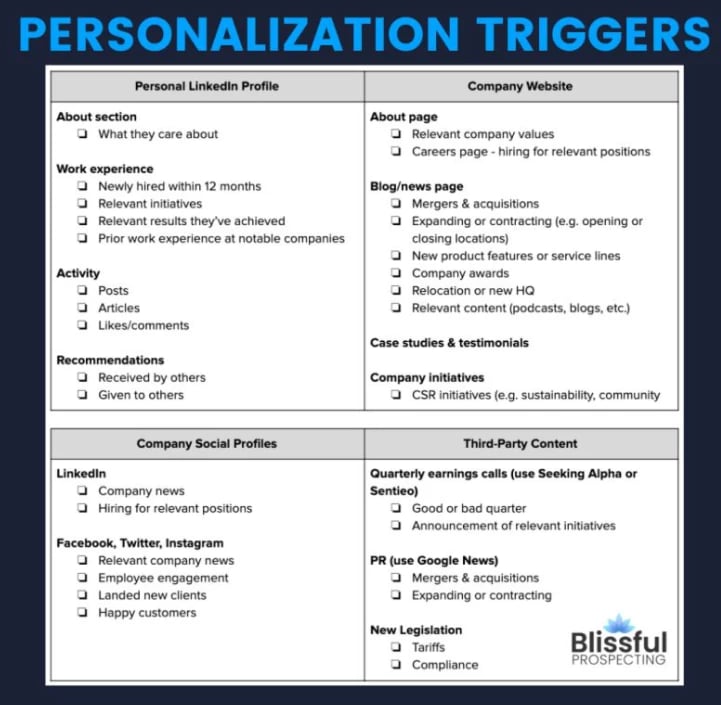
Jason Bay's “personalization triggers.”
This is what we call personalization at scale. It doesn't take away the homework each rep needs to do to write a message that will resonate with the buyer, but it empowers them with the tools they need to create highly personalized buyer experiences at scale. By sending reminders, and adding tasks and calls to your calendar, Mixmax makes it a lot easier for your reps to be more productive and do your job better.
Enable your buyers to reply with one click
Unresponsive prospect or customer? What if all they had to do was click?
Increase your reply rates by embedding polls in-email.
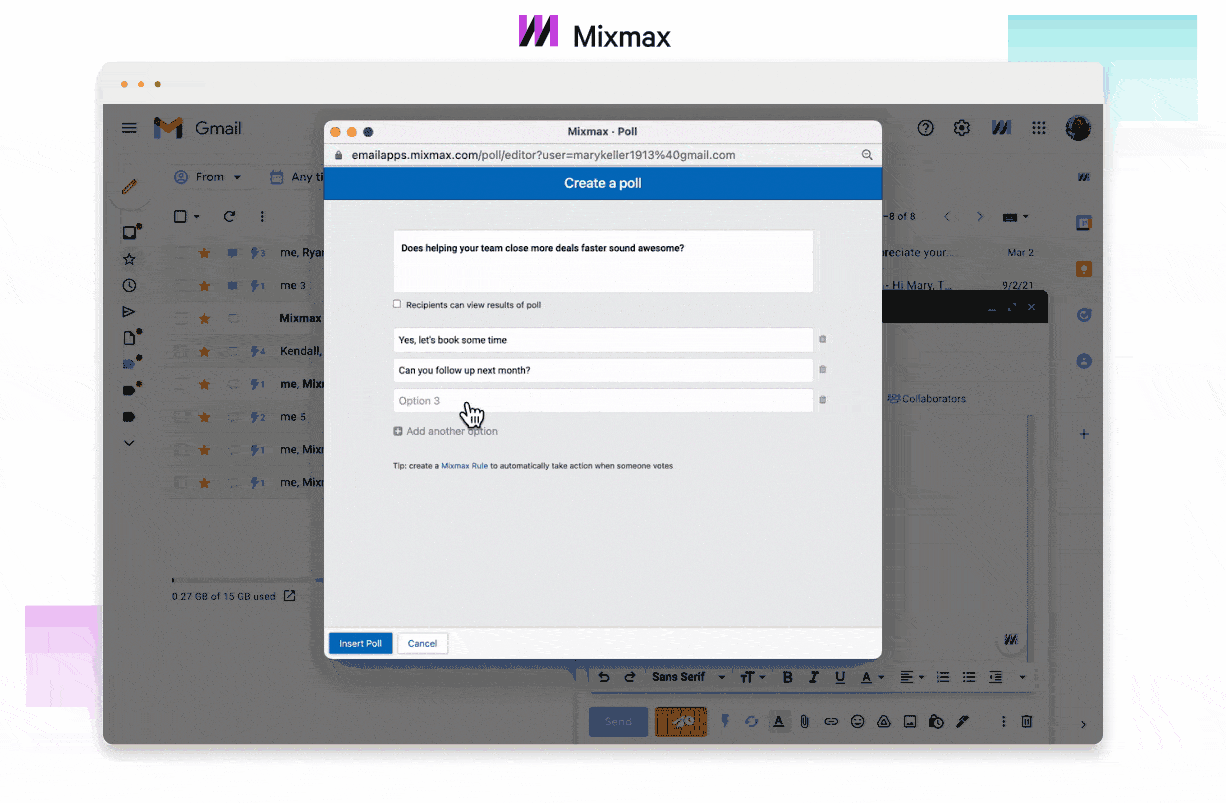 Mixmax rules allow you to trigger personalized follow-ups based on their answers.
Mixmax rules allow you to trigger personalized follow-ups based on their answers.
Speaking of follow-ups...>
Follow up, always
Follow-up matters at every stage of your customer journey. No matter if your reps are trying to get that initial meeting, or close a deal, staying top of mind can make or break it.
And let’s be real… they won’t remember to follow up on that email if they don’t get a reply. They've got too much going on.
With Mixmax, they can set a reminder to follow up if someone doesn’t get back to them by a specific date. It’s one of those little things that just makes a huge difference and ensures no deal falls through the cracks.
Also, instead of following up manually every time, you can follow up with a sequence most helpful for your prospects' situation.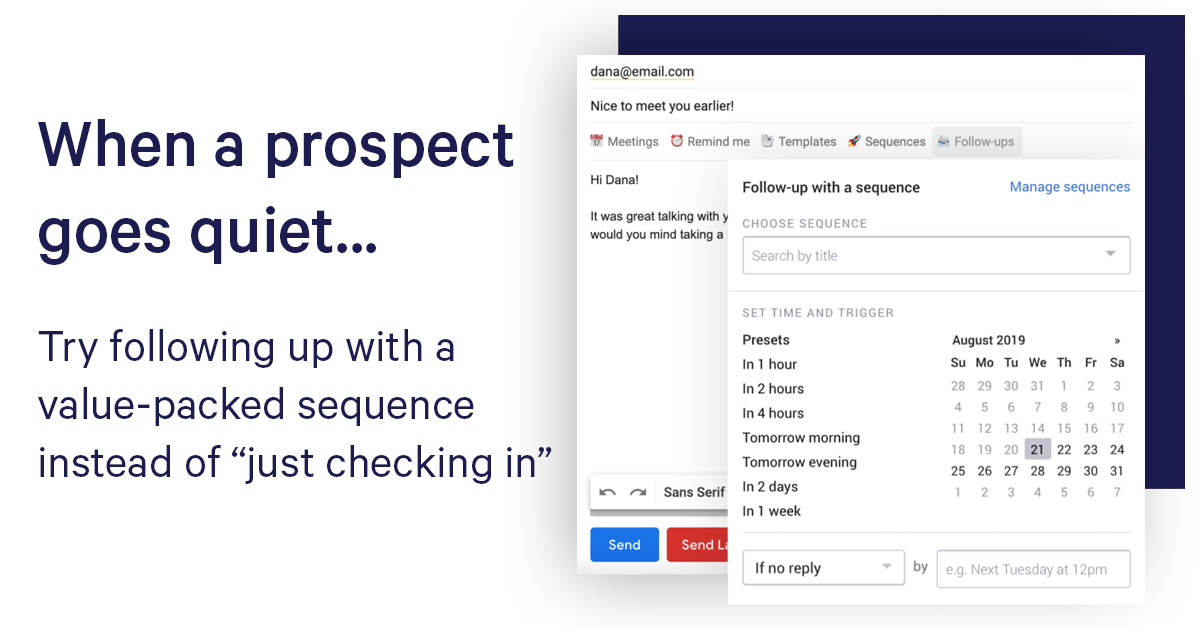
Automate workflows based on customer interactions
Rather than simply relying on an automated sequence, use Mixmax rules to set up trigger events based on engagement.
For example, get a Slack message when your recipient opens an email three times, prompting you to follow up with a Linkedin request or have a call task created.
Log activity to your CRM, automatically
“Did you update your Salesforce?” - Every Sales Manager. Don’t let CRM tasks weigh your reps down.
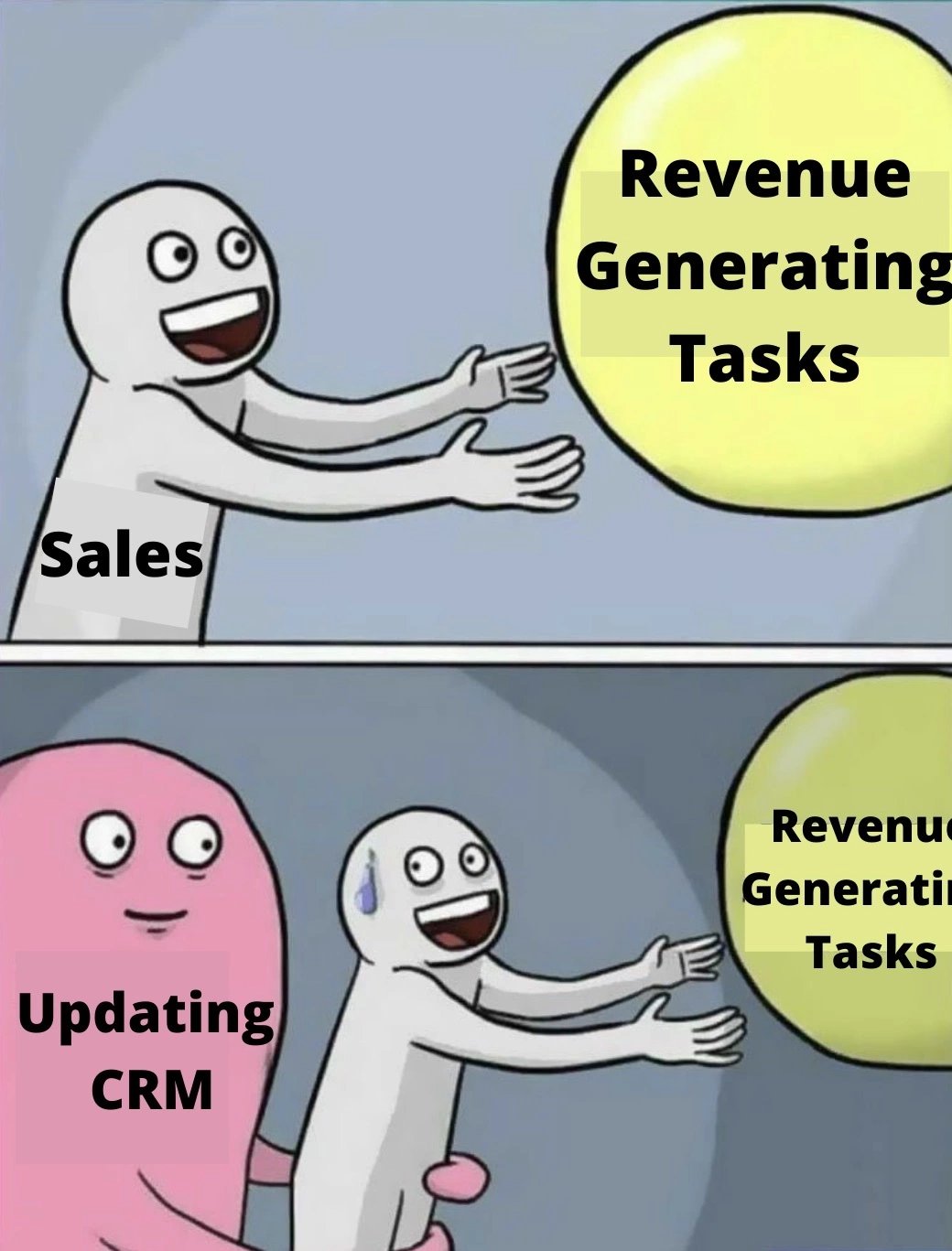
Choose a sales engagement platform that integrates with your CRM.
Mixmax seamlessly integrates Salesforce with your Gmail. All your CRM insights are visible from a handy sidebar in Gmail, thus eliminating the need to constantly switch tabs to get anything done.
From making it easier to personalize messages, to automatically logging phone and email activity, Mixmax frees your reps to sell.
Looking to scale your sales email efforts? Mixmax makes it easy to personalize outreach at scale for better results. Request a demo
Frequently asked questions about sales emails
What is the best time to send sales emails?
You might read that the middle of the week is the best time to send sales emails. But in truth: the best time to send a sales email is when the recipient is actively going through their inbox.
Using a sales engagement platform like Mixmax, you’ll be able to see when is the best time to send sales emails based on your activity with the recipient.
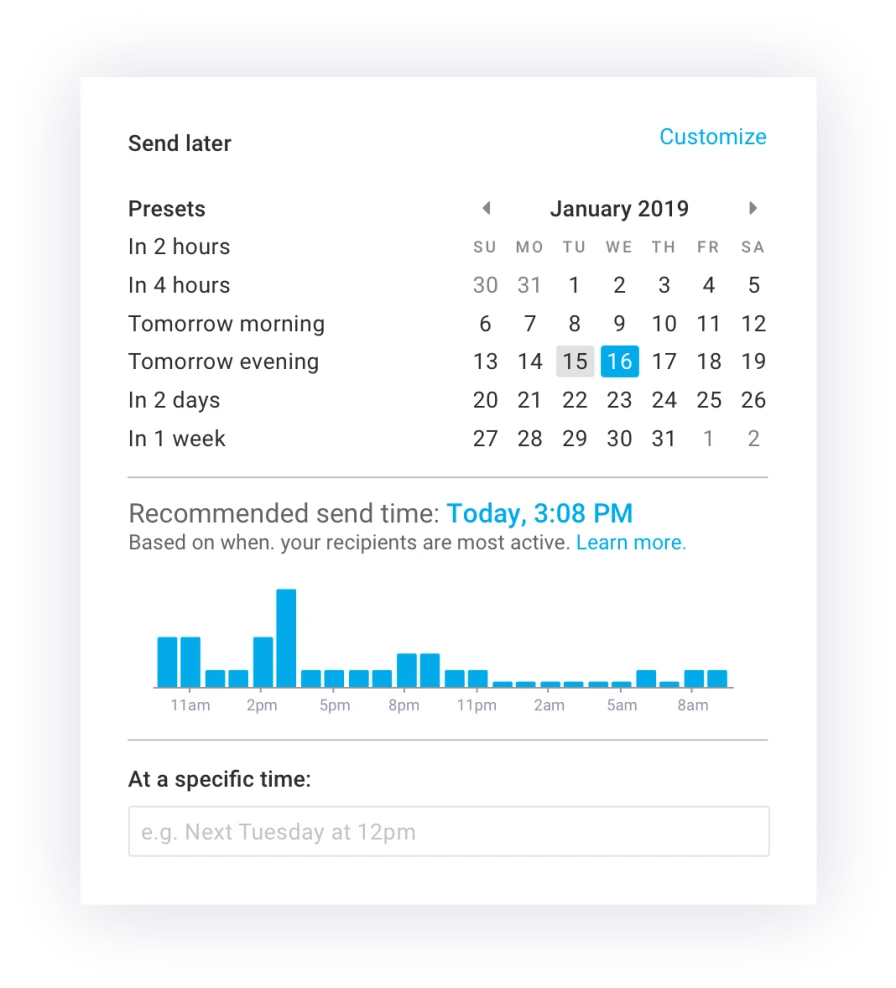
This approach will help ensure you’re staying top of mind and not ending up in the trash simply because they couldn’t be bothered to reply come Monday morning.
How long should a sales email be?
Finding the sales email is kind of like searching for the fabled Goldilox. Too short and you’re not adding value. Too long and you’re asking for too much of their time.
Luckily, a data team at Gong Labs analyzed 304,174 emails to learn which prospecting email length booked more meetings. The results? Follow-up emails with four sentences were 15% more likely to get a reply than emails shorter in length. So, dear friends, the point isn’t just to be brief but rather to be impactful. Because as Gong Labs stated, “You can afford a longer email if your email is personalized, direct, and intentional in every sentence.”
What are the best words to use in a sales email?
Steal from the copywriters when it comes to peppering your email with power words.
-
“You” – make sure you’re always talking about your prospects' needs
-
“Because” – According to a study conducted by psychology professor Ellen Langer, when the stranger simply asked if they could jump ahead in line, they were successful 60% of the time. Adding “because I’m in a rush” rose the success rate to 94%. Ex: “Because you’ve shown interest in [x], you’d make a great candidate for [y]...”
-
“Still” – a power word to showcase you understand the problem the prospect is facing and their inability to move forward. Ex: “Are you still using outdated methods in [x]…?”
How do you track sales emails?
Thanks to email tracking software, you now have the tools to optimize your approach and capture data on open rates, click-through rates, and overall engagement.
This is ultra-important because the best time to call your prospect is right when they finish. With a tool like Mixmax, you can know when they finished reading, down to the very second. Get a notification in real-time (rather than batch alerts) allowing you to pick up the phone and go in for the close.




















